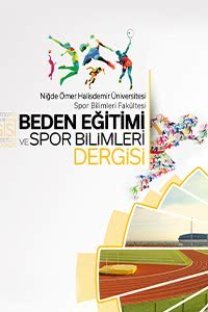ANALYSIS OF RESILIENCY LEVELS OF DISABLED INDIVIDUALS DOING SPORTS ACCORDING TO SOME VARIABLES
SPOR YAPAN BEDENSEL ENGELLİ BİREYLERİN ÇEŞİTLİ DEĞİŞKENLERE GÖRE YILMAZ DÜZEYLERİNİN İNCELENMESİ
___
- 1. Baltaş, A. ve Baltaş, Z. Stres ve başa çıkma yolları. İstanbul: Remzi Yayınevi. (2002). [in Turkish]
- 2. Benard, B., The foundations of the resiliency paradigm. Premier Issue. 1996.
- 3. Garmezy, N., Rutter, M. Stress, coping and development in children. New York, Mc Graw- Hill(1985).
- 4. Gordon, K., Resilient Hispanic Youths Self- Concept and Motivational Patterns. Hispanic Journal of Behavioral Sciences, 18, 1, 63, 1996.
- 5. Gürgân, U., Resilience scale (YÖ):Scale development, reliability and validity work , Ankara University , Faculty of educational sciences journal, 32 (2);45-74, 2006. [in Turkish with English Abstract]
- 6. Gürgân, U., Effect of the psychological counselor in the group to the resilience level of the students, doctoral thesis, Ankara University, Institute of education sciences, Department of education sciences , Program of psychological counseling and guidance, Ankara, 2006. [in Turkish]
- 7. Hoge, E. A., Austin, E. D. & Pollack, M. H. (2007). Resilience: Research evidence and conceptual considerations for posttraumatic stress disorder. Depression and Anxiety, 24, 139152. doi:10.1002/da.20175(2007).
- 8. Howard, S., & Johnson, B., What Makes The Difference? Children and Teachers Talk About Resilient Outcomes For Children "At Risk". Educational Studies, 26 (3), 2000.
- 9. Jew, C. L., Green, K. E., Kroger, J. Development and validation of a measure of resiliency. Measurement and Evaluation in Counseling and Development, 32, 75-89. (1999).
- 10. Jew, C. L., Green, K. E., Kroger, J. (1999). Development and validation of a measure of resiliency. Measurement and Evaluation in Counseling and Development, 32, 75-89(1999).
- 11. Kirby, L.D., Fraser, M. W. Risk and resilience in childhood. In M. Fraser (Ed.), Risk and resilience in childhood (pp. 10-33). Washington, DC: NASW Press. (1997).
- 12. Margalit, M., Resilience model among individuals with learning disabilities: proximal and distal influences. Learning Disabilities Research Practice, 18, 2, 82-87. 2003.
- 13. Masten, A. S. Reed, M. J. Resilience in development. In C. R. Snyder S. J. Lopez (Eds.), The handbook of positive psychology (pp. 74- 88). Oxford University Press. (2002).
- 14. Masten, A. S., Morison, P., Pellegrini, D. Teliegen, A. (1990). Competence under stress: risk and protective factors. In J. Rolf, A. S. (1990).
- 15. Masten, D. Cicchetti, K. H. Nuechterlein S. Weintraub (1998), Risk and protective factors in the development of psychopathology (pp. 236-256). New York: Cambridge University Press. (1998),
- 16. Miller, M., Resilience Elements in Students With Learning Disabilities. Journal of Clinical Psychology, 58, 2002
- 17. Öğülmüş, S., Resilience as a personality trait. I. National child and crime symposium: Reasons and preventions Works, 29-30 March 2001. [in Turkish with English Abstract]
- 18. Rak, C. F., & Patterson, L. E., Promoting Resilience in At-Risk Children, Journal Of Counseling & Development, 74 (4), 368374. 1996.
- 19. Sarı, O. T. Kaynaştırma Eğitimi ve Rehberlik. Psikolojik Danışma ve Rehberlik. Birsen Yayınevi (sf 331-341). İstanbul. (2004). [in Turkish]
- 20. Vance, E., & Sanchez, H., Creating A service System That Builds Resiliency. NC Department Of Health And Human Services. 1998.
- 21. Werner, E. E., Smith, R. S. Overcoming the odds: High-risk children from birth to adulthood. New York: Cornell University Pres. (ED 344979) (1992).
- ISSN: 1307-6477
- Yayın Aralığı: Yılda 3 Sayı
- Başlangıç: 2007
- Yayıncı: Niğde Üniversitesi Beden Eğitimi ve Spor Yüksek Okulu
THE EFFECTS OF SPORTING HABIT ON STUDENTS' ACADEMIC ACHIEVEMENTS AND LEVEL OF LEARNED HELPLESSNESS
MURAT ELİÖZ, TÜLİN ATAN, MEHMET ÇEBİ, MEHMET İMAMOĞLU
DEVELOPMENT OF ORGANIZATIONAL STRESS SCALE FOR ATHLETES
HANİFİ ÜZÜM, NEVZAT MİRZEOĞLU, ERCAN POLAT, SELÇUK AKPINAR
THE CURRENT STATE OF TENNIS IN IZMIR
PINAR GÜZEL, Hülya ÜNLÜ, SELHAN ÖZBEY
TALHA MURATHAN, ÜMİT YETİŞ, FATİH MURATHAN, ZAİT BURAK AKTUĞ, AYKUT DÜNDAR
DENİZ ŞİMŞEK, ALİ ONUR CERRAH, HAYRİ ERTAN
Menstrual status differences of elite Turkish female athletes from various team sports
Selma KARACAN, F. Filiz ÇOLAKOĞLU, Gülfem ERSÖZ
EBRU OLCAY KARABULUT, ZİYA BAHADIR
EXPLORING THE PERCEPTIONS OF THE VOLUNTEERS FOR THE 2011 EUROPEAN YOUTH OLYMPICS THROUGH METAPHORS12
FATİH BEKTAŞ, GAMZE BEYAZOĞLU BACI, İBRAHİM YILDIRAN, İdris YILMAZ
THE COMBINATION OF MENTAL AND PHYSICAL PRACTICES IS BETTER FOR INSTRUCTION OF A NEW SKILL
